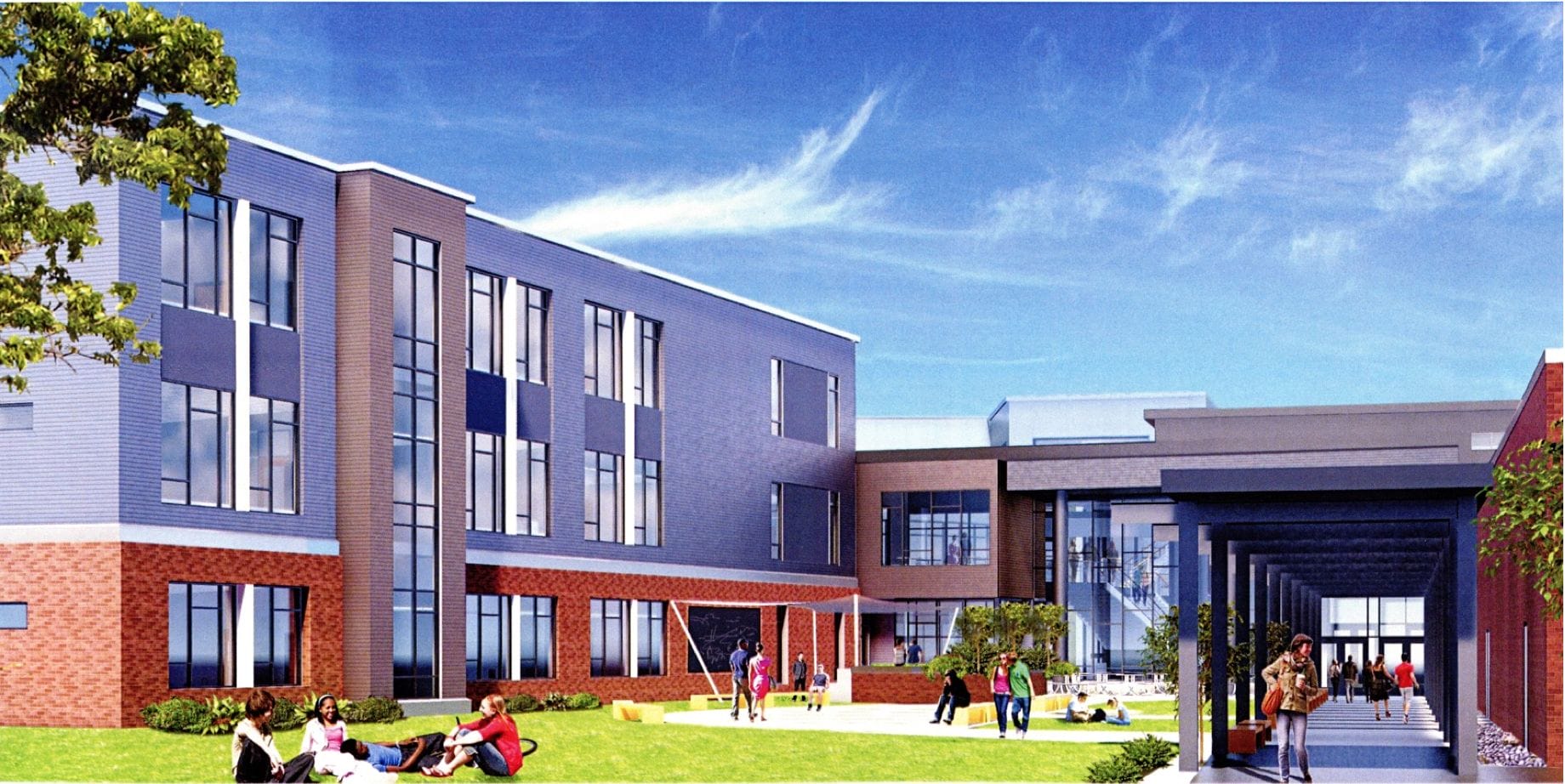
A conceptual drawing of the city’s second high school, scheduled to open in the fall of 2022. The school board announced this month that the new school will host specialized STEM programs.
By Liesl Graber, contributor
At last Thursday’s Northeast Neighborhood Association meeting, Schools Superintendent Michael Richards spent an hour answering questions from community members about districting and programming after the city opens a second high school in the fall of 2022.
Most of the discussion addressed concerns about equity raised by some after the school board announced earlier this month that the new high school will offer specialized STEM programs while the existing high school will emphasize fine arts.
“What’s the point of having a beautiful high-tech school if only some students will have access to it?” asked Paloma Saucedo, who ran as an Independent for city council last fall.
On social media in recent weeks, Saucedo and others have criticized the STEM focus at the new high school, concerned that it will become a privileged, white school, with students of color more likely to attend the existing, overcrowded high school.
About 20 people attended the meeting at Lucy F. Simms school – the second in a series of public engagement sessions school officials have scheduled through December as they continue planning for the new school’s opening. Joining Richards was Vice-Mayor Sal Romero, the city schools’ Coordinator of Family and Community Engagement.
Responding to Saucedo and others who raised similar concerns, Richards said equity will be the first consideration in drawing new high school district boundaries. The goal, he said, is for the demographics of each district to reflect those of the city’s entire student population, with the districting team prepared to spend as much time as necessary to make the best decision.
“We’re not just going to split the city along Route 11 and call it good,” he said.
In addition to race, socioeconomic status will be another important factor the districting committee will consider when drawing the lines, Romero added.
Two schools designed to offer complementary programs
Since announcing the STEM and fine arts focuses at the two high schools, schools officials have said the different programs will offer more opportunities for all city students.
“The easy thing would be to cut and paste, make both schools look and function exactly the same. But they would both be weaker that way,” said School Board Chair Deb Fitzgerald, in an interview with The Citizen. “We could have two mediocre schools or two schools that offer two specialized programs that are really good at what they do. With this design, HHS can continue to offer programs to all students in ways that are accessible to everyone.”
Fitzgerald was unable to attend the meeting last Thursday.
The new school will house the STEM programs because building new laboratory space that can accommodate changing future needs – with features like the hollow interior walls and moveable ceilings – is “just not something we can do in the existing building,” Richards said.
Likewise, keeping the arts in the existing high school building is more cost-effective because of its existing theater space, he added.
Regardless, Richards said, both high schools will offer all the classes to meet core graduation requirements, with transportation between the two available for students who want to study in either of the specialized programs. Students districted to attend the existing high school, for example, will be able to take basic STEM classes there, and could take the bus to the new high school for classes that require use of its high-tech STEM labs. Likewise, students at the new school who want to take a dance course not offered there could take it at the existing high school.
Before starting the city superintendent job this May, Richards was chief of staff for Loudoun County Public Schools, which offers school-specific programs similar to the system proposed for Harrisonburg. In Loudon County, students from any school can be transported to three specialized academies – one for Engineering and Technology, one for Science and Research, and one for Career and Technical development.
Fitzgerald noted that Harrisonburg High School already allows students to pursue specialized classes in other locations, like the Massanutten Technical Center, Blue Ridge Community College, or the Massanutten Regional Governor’s School.
Questions remain
As the meeting wound down, not all attendees seemed totally sold on the promise of equal opportunity for all students. On a related noted, questions were also raised about the school system’s efforts to increase staff diversity. Richards responded that diversifying the schools’ staff is an ongoing priority being pursued through expanded recruiting efforts and new strategies to increase retention of teachers of color.
Throughout the rest of the year, Romero and Richardson will continue visiting various groups throughout the city and offering similar opportunities for questions and discussion.
In an interview afterwards, Fitzgerald called these meetings “Road Shows,” the purpose of which, she said, is to say, “Look, here’s what we’re doing. Here what we’re saying we’ll do. Keep us accountable, please.”
Journalism is changing, and that’s why The Citizen is here. We’re independent. We’re local. We pay our contributors, and the money you give goes directly to the reporting. No overhead. No printing costs. Just facts, stories and context. Thanks for your support.

